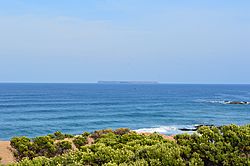Lady Julia Percy Island facts for kids
|
Native name:
Deen Maar
|
|
|---|---|

Lady Julia Percy Island seen from the Yambuk Flora and Fauna Reserve
|
|
| Geography | |
| Location | Bass Strait |
| Coordinates | 38°25′30″S 142°00′00″E / 38.42500°S 142.00000°E |
| Area | 1,330 ha (3,300 acres) |
| Length | 2.4 km (1.49 mi) |
| Width | 1.2 km (0.75 mi) |
| Administration | |
|
Australia
|
|
| State | Victoria |
Lady Julia Percy Island, known as Deen Maar or Dhinmar in the Gunditjmara language, is an island located about 6 kilometers off the coast of Victoria, Australia. It sits in the Bass Strait and is a special place for both its natural environment and its history.
Contents
About Lady Julia Percy Island
This island is found about 12 kilometers southwest of Yambuk and 22 kilometers southwest of Port Fairy. It's about 2 kilometers long and 1 kilometer wide, covering an area of 1.33 square kilometers. The island has a flat top, called a plateau, which is between 32 and 46 meters above sea level. This plateau is surrounded by cliffs, rocky areas, and reefs.
Lady Julia Percy Island is home to an important colony of seals. It has been used by people for a very long time, which has changed its plant life. However, it is now a protected State Faunal Reserve. You can get the best views of the island from places like The Crags or Yambuk Lake.
Island History
Deen Maar was very important to the Gunditjmara people. They believed that the spirits of people who had passed away traveled across the sea to the island. This journey started from a cave called Tarnwirring, which means "the flowing of the wind." The island was also known as Tirngoona, meaning "where the sun goes away at night."
How the Island Got its Name
In 1800, Lieutenant James Grant named the island "Lady Julia’s Island." He likely named it after the wife or daughter of Hugh Percy, 2nd Duke of Northumberland. Two years later, in 1802, Matthew Flinders sailed past on his ship, the Investigator, and expanded the name to Lady Julia Percy's Island. Also in 1802, Nicolas Baudin sailed by in his ship, the Géographe, and called it Ile aux Alouettes, but this name did not last.
Past Activities on the Island
In the early 1800s, people used to hunt seals on the island. Seal hunters would live there for many months at a time. There are two graves on the island from this period. One is for a seal hunter buried in 1822, and the other is for a man named Hardman, buried in 1828.
People also mined guano (bird droppings used as fertilizer) on the island until 1861. This guano was taken to Port Fairy by barges. In January 1936, a group of scientists from Melbourne University visited the island for six weeks. They studied the island's environment very carefully.
Island Environment
Geology and Formation
Lady Julia Percy Island was formed about seven million years ago. This makes it much older than other volcanoes in the area. It's also special because it was created by both underwater and land eruptions. You can see different layers of lava in the coastal cliffs, showing six separate lava flows. It is Australia’s only volcano located offshore and the only large basalt island off the coast of western Victoria.
Plant Life (Flora)
A scientist named Frederic Wood Jones visited the island in 1936. He noted that a century before, the island was covered in thick, bushy plants. However, by 1936, most of the island's flat top was bare, with only bracken fern and thistles growing. He explained that this change was due to human activity. People had brought pigs and rabbits to the island, and seal hunters and guano workers had cut down and burned the trees.
Today, the island's plateau is windy and mostly bare. It has no trees and is mainly covered with grasses and bracken growing in thin, dark soil. A special plant called the Shore Spleenwort (Asplenium obtusatum), which is a vulnerable species, still grows there.
Animal Life (Fauna)
Lady Julia Percy Island is one of only four places in Victoria where Australian fur seals breed. With an estimated 27,000 seals, it is the largest fur seal colony in Australia! Sometimes, Australian sea lions and southern elephant seals also visit the island. The pigs and rabbits that were brought to the island in the past are no longer there.
The island is also a breeding ground for many birds. These include about 2,000 pairs of little penguins, 1,000 pairs of common diving-petrels, 1,000 pairs of fairy prions, and 15,000 pairs of short-tailed shearwaters. The only reptile found on the island is White's skink. The waters around the island are also visited by great white sharks.
Visiting the Island
You cannot visit Lady Julia Percy Island without a special permit. However, boat tours from Port Fairy are very popular. These tours allow people to see the large seal colony and watch whales and seabirds in the waters around the island.


